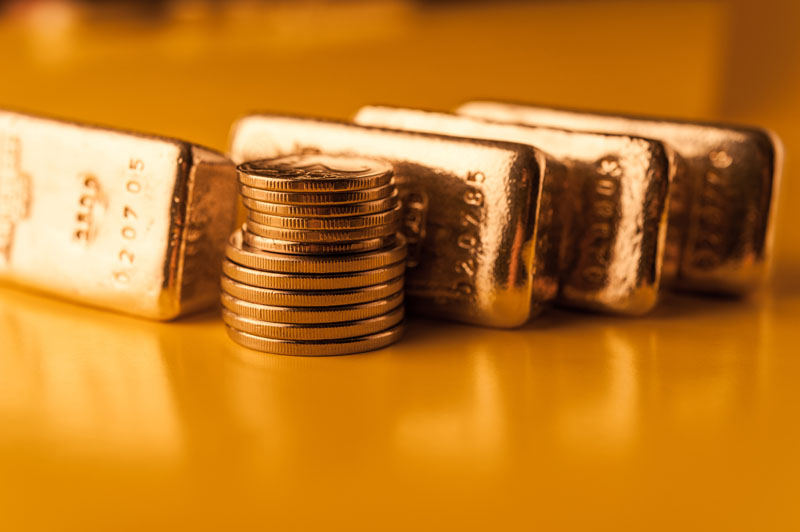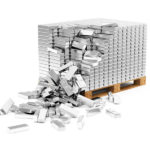Commentary: The Gold Party Has Only Just Begun
 (December 6, 2019 - Ronald-Peter Stoferle - Special to The Northern Miner)
(December 6, 2019 - Ronald-Peter Stoferle - Special to The Northern Miner)
The year 2019 has been good for gold. In many currencies gold recorded all-time highs (i.e. euro, Canadian dollar and Australian dollar), with the exception of the U.S. dollar. As things stand, 2020 will become a good year for gold as well because the factors supporting higher gold prices already present in 2019 will remain in 2020, such as negative interest rates, rising debt levels and the central banks’ renewed interest in gold. There is also rising inflation and a slowdown in economic growth — if not a recession.
Factors that support a gold-price rise in 2020
Let’s have a closer look at the trends.
Higher debt levels worldwide should drive the gold price in 2020, as well as its corollary, the trend towards ever more politicized central banks. Be it U.S. President Donald Trump’s numerous tweets pressuring Jerome Powell to cut interest rates — and this environment of ultra-low interest rates will not end soon, as I explore in detail in my new book The Zero Interest Trap — or be it the call on central banks to finance a Green New Deal, or the affirmative answers of central bankers like the new president of the European Central Bank, Christine Lagarde, a politician herself, to this call. The more politicized a central bank gets, the less independent a central bank becomes, and inflation rates can increase. And gold has been, is, and will be the perfect hedge against high(er) inflation.
There is another threat to low inflation rates. In recent months, ideas such as the modern monetary theory, helicopter money and quantitative easing for the people have gained more popularity. All these concepts fall prey to the illusion that printing money, not innovation and hard work, is the prerequisite for economic growth. And as ideas do matter, this shift in public perception makes higher inflation rates more likely.

Cooling doré from Para Resources’ Gold Road gold mine in
Arizona. Credit: Para Resources.
A pickup in inflation rates would have a tremendous impact on the bond market — precisely on the bond market bubble. Bonds worth more than US$17 trillion have a negative yield. Higher inflation rates would lead to losses on the bond markets and signify to investors that risk has returned to the bond market, like what happened on the stock markets in the fourth-quarter of 2018. Gold will become more attractive for these financially potent investors.
Especially in Europe, but also in the U.S. and China, reports of slower economic growth have become the new normal. These reports are underpinned by the earnings recession, planned mass layoffs and inverted yield curves, while politicians and even central bankers call for fiscal stimuli. It is time to prepare for a recession. But how does gold perform in a recession?
In our 2019 report “In gold we trust,” we conducted thorough research on gold’s performance in the various stages of a recession. Our results are that gold has been excellent at offsetting stock losses during recessions. There is no reason to expect that gold will not record substantial gains and will not act as a hedge against bear stock markets, as well. However, one should be less optimistic about bonds, the classic stock diversifier. High debt, the zombification of the economy, and monetary policy that is still very loose by historical standards combine to undermine the ability of bonds to act as a stock diversifier. Therefore, gold is positioned to remain an indispensable component of the portfolio in the future, as it lets the investor navigate stressful passages in the market with relative ease.
Central banks’ gold purchases change public perception of gold
Gold’s perception has changed dramatically in recent years, and this U-turn will not be undone soon — exemplified by the remarkable shift in the central banks’ actions and communication regarding gold. For many decades, gold has been considered the “barbarous relic” of a time long gone. As gold does neither earn interest nor dividends, central banks lowered their gold holdings step-by-step. Then the financial crisis of 2007–2008 changed everything. In 2008, central banks left the camp of net sellers and became net buyers of gold. This trend has continued ever since.
In buying 657 tons (596 tonnes) of gold in 2018, central banks globally have made the largest gold purchases since the end of Bretton Woods in 1971. Russia, with 274 tons (245 tonnes), Kazakhstan 50 tons (45 tonnes), and India 42 tons (38 tonnes), made up the largest buyers, while Hungary and Poland, two EU members that have not introduced the euro, rank fourth and fifth. Poland made its largest purchase since 1998, while Hungary increased its meagre gold reserves tenfold.
The high demand from central banks continued in the first three quarters of 2019. According to the World Gold Council, central banks increased their gold reserves 548 tons (497 tonnes) by the end of September — 12% higher than the same period in 2018. It is quite likely that 2019 will set a record. These developments are in line with the results of a survey conducted by the World Gold Council: 76% of central banks consider gold as a highly relevant safe haven asset and 59% valued gold’s effectiveness as a portfolio diversifier.
Another reason for countries like Russia and China to bolster their gold reserves is the ongoing process of declaring independence from the U.S. dollar as the global reserve currency, commonly referred to as “de-dollarization.” Another facet of this trend towards re-nationalization is that more countries repatriate at least a significant share of their gold reserves. Poland, Serbia and Slovakia recently joined this club.
There is no indication that these trends will lose momentum in 2020. The geopolitical tensions are here to stay, at least until the presidential elections in the U.S., and in all likelihood after the elections as well, regardless of whether the incumbent president wins his second term or not.
But central banks’ actions as well as attitude about gold have become more positive. Bearing in mind that central banks are known for their balanced and careful wording, and given that all major actors in charge of financial market stability are eager to uphold the impression that everything is fine, the verbal advocacy of gold is telling.
Case in point is the Central Bank of Hungary (MNB). When the MNB conducted its first gold purchases since 1986 last year, increasing its gold reserves tenfold, it published the following press statement: “In normal circumstances, gold has a confidence-building feature, i.e., it may play a stabilizing role and act as a major line of defence under extreme market conditions, or in times of structural changes in the international financial system or deep geopolitical crises. In addition, gold continues to be one of the safest assets, which can be related to individual properties such as the limited supply of physical precious metal, which is not linked with credit or counterparty risk, given that gold is not a claim on a specific counterparty or country.”
This renewed interest of central banks in gold will change the perception of the metal. If even central banks underpin gold’s importance and strengths, a broader public should get interested in gold investments.
This holds particularly true as alternative investment opportunities become less attractive. As nominal interest rates continue on a downward path, and as more and more banks in Germany, for example, pass on negative nominal interest rates to consumers, negative real interest rates will become or remain the reality. As empirical evidence shows, negative real interest rates tend to boost the gold price. With respect to the stock markets, the sharp losses in fourth-quarter 2018 show that despite the ongoing rallies, stock markets have become more vulnerable. And as stock markets tumbled in the fourth-quarter of 2018, gold could not only withstand the plunge, it reacted as a safe haven asset should react: gold went up.
2020 will be another golden year
Predictions about the future are always difficult and predictions about the gold price are no exception to this rule. But more factors that drag on the gold price are disappearing. Still lacking in our list are the decisions by the Federal Reserve and the European Central Bank at their respective meetings in September to halt the process of monetary normalization, which was in its infancy at best, and to open the monetary floodgates anew. Bearing in mind that gold has surpassed the psychologically important resistance zone between US$1,360 per oz. to US$1,380 per oz,, we are confident that in 2020 the gold price in U.S. dollars should get closer to its all-time high, because the gold party has only just begun.
— Based in Liechtenstein, Ronald-Peter Stoferle is a partner of Incrementum AG and is responsible for research and portfolio management. Incrementum AG specializes in owner-managed and fully licensed asset and wealth management. For more information and to view the full “In gold we trust” 2019 report, coauthored by Incrementum AG partner Mark Valek, who is responsible for portfolio management and research, visit: https://ingoldwetrust.report.






